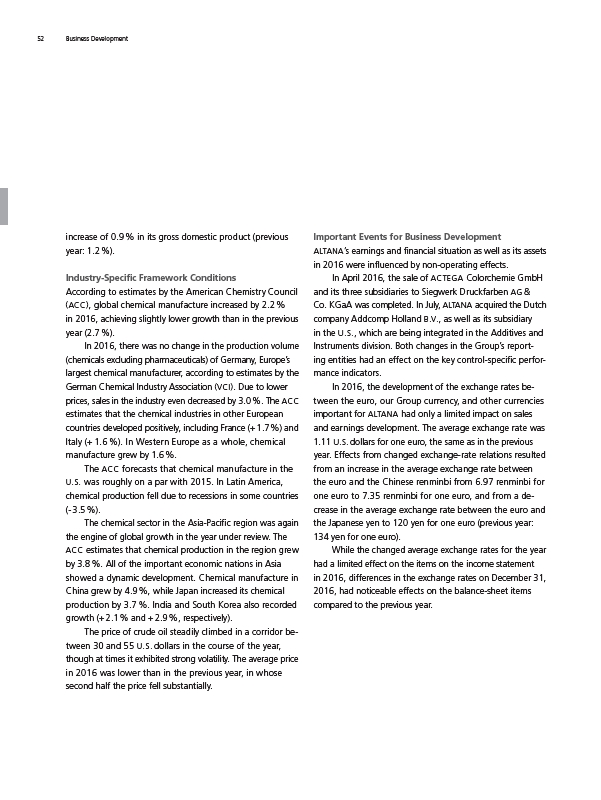
Important Events for Business Development
ALTANA’s earnings and financial situation as well as its assets
in 2016 were influenced by non-operating effects.
In April 2016, the sale of ACTEGA Colorchemie GmbH
and its three subsidiaries to Siegwerk Druckfarben AG &
Co. KGaA was completed. In July, ALTANA acquired the Dutch
company Addcomp Holland B.V., as well as its subsidiary
in the U.S., which are being integrated in the Additives and
Instruments division. Both changes in the Group’s reporting
entities had an effect on the key control-specific performance
indicators.
In 2016, the development of the exchange rates between
the euro, our Group currency, and other currencies
important for ALTANA had only a limited impact on sales
and earnings development. The average exchange rate was
1.11 U.S. dollars for one euro, the same as in the previous
year. Effects from changed exchange-rate relations resulted
from an increase in the average exchange rate between
the euro and the Chinese renminbi from 6.97 renminbi for
one euro to 7.35 renminbi for one euro, and from a de-
crease in the average exchange rate between the euro and
the Japanese yen to 120 yen for one euro (previous year:
134 yen for one euro).
While the changed average exchange rates for the year
had a limited effect on the items on the income statement
in 2016, differences in the exchange rates on December 31,
2016, had noticeable effects on the balance-sheet items
compared to the previous year.
52 Business Development
increase of 0.9 % in its gross domestic product (previous
year: 1.2 %).
Industry-Specific Framework Conditions
According to estimates by the American Chemistry Council
(ACC), global chemical manufacture increased by 2.2 %
in 2016, achieving slightly lower growth than in the previous
year (2.7 %).
In 2016, there was no change in the production volume
(chemicals excluding pharmaceuticals) of Germany, Europe’s
largest chemical manufacturer, according to estimates by the
German Chemical Industry Association (VCI). Due to lower
prices, sales in the industry even decreased by 3.0 %. The ACC
estimates that the chemical industries in other European
countries developed positively, including France (+ 1.7 %) and
Italy (+ 1.6 %). In Western Europe as a whole, chemical
manufacture grew by 1.6 %.
The ACC forecasts that chemical manufacture in the
U.S. was roughly on a par with 2015. In Latin America,
chemical production fell due to recessions in some countries
(- 3.5 %).
The chemical sector in the Asia-Pacific region was again
the engine of global growth in the year under review. The
ACC estimates that chemical production in the region grew
by 3.8 %. All of the important economic nations in Asia
showed a dynamic development. Chemical manufacture in
China grew by 4.9 %, while Japan increased its chemical
production by 3.7 %. India and South Korea also recorded
growth (+ 2.1 % and + 2.9 %, respectively).
The price of crude oil steadily climbed in a corridor be-
tween 30 and 55 U.S. dollars in the course of the year,
though at times it exhibited strong volatility. The average price
in 2016 was lower than in the previous year, in whose
second half the price fell substantially.